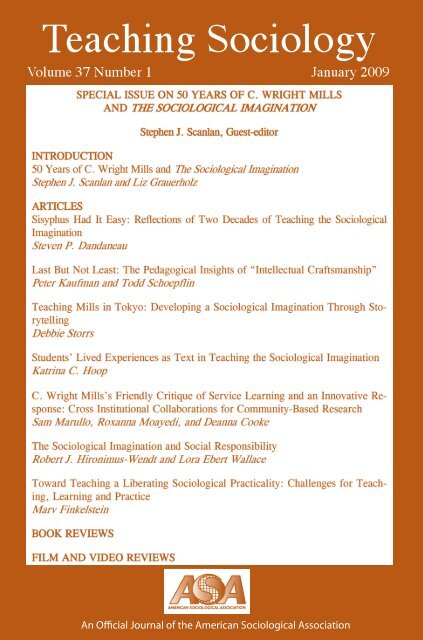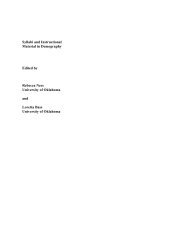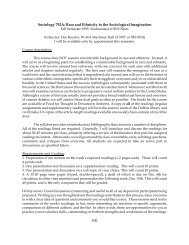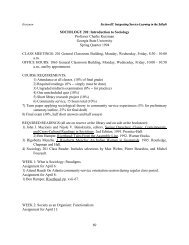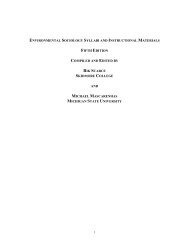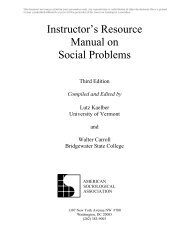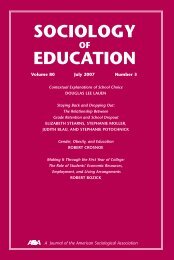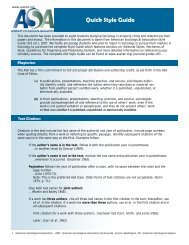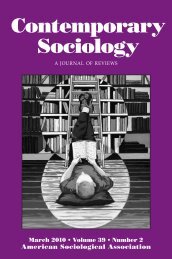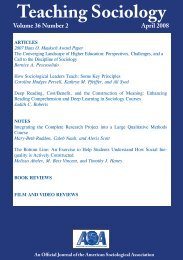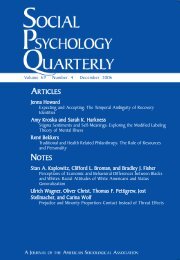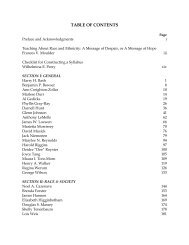Teaching Sociology - American Sociological Association
Teaching Sociology - American Sociological Association
Teaching Sociology - American Sociological Association
You also want an ePaper? Increase the reach of your titles
YUMPU automatically turns print PDFs into web optimized ePapers that Google loves.
<strong>Teaching</strong> <strong>Sociology</strong><br />
Volume 37 Number 1 January 2009<br />
SPECIAL ISSUE ON 50 YEARS OF C. WRIGHT MILLS<br />
AND THE SOCIOLOGICAL IMAGINATION<br />
Stephen J. Scanlan, Guest-editor<br />
INTRODUCTION<br />
50 Years of C. Wright Mills and The <strong>Sociological</strong> Imagination<br />
Stephen J. Scanlan and Liz Grauerholz<br />
ARTICLES<br />
Sisyphus Had It Easy: Reflections of Two Decades of <strong>Teaching</strong> the <strong>Sociological</strong><br />
Imagination<br />
Steven P. Dandaneau<br />
Last But Not Least: The Pedagogical Insights of “Intellectual Craftsmanship”<br />
Peter Kaufman and Todd Schoepflin<br />
<strong>Teaching</strong> Mills in Tokyo: Developing a <strong>Sociological</strong> Imagination Through Storytelling<br />
Debbie Storrs<br />
Students’ Lived Experiences as Text in <strong>Teaching</strong> the <strong>Sociological</strong> Imagination<br />
Katrina C. Hoop<br />
C. Wright Mills’s Friendly Critique of Service Learning and an Innovative Response:<br />
Cross Institutional Collaborations for Community-Based Research<br />
Sam Marullo, Roxanna Moayedi, and Deanna Cooke<br />
The <strong>Sociological</strong> Imagination and Social Responsibility<br />
Robert J. Hironimus-Wendt and Lora Ebert Wallace<br />
Toward <strong>Teaching</strong> a Liberating <strong>Sociological</strong> Practicality: Challenges for <strong>Teaching</strong>,<br />
Learning and Practice<br />
Marv Finkelstein<br />
BOOK REVIEWS<br />
FILM AND VIDEO REVIEWS<br />
An Ocial Journal of the <strong>American</strong> <strong>Sociological</strong> <strong>Association</strong>
Editor<br />
Liz Grauerholz<br />
University of Central Florida<br />
email: TS@mail.ucf.edu<br />
Maxine Atkinson<br />
North Carolina State University<br />
Rebecca Bordt<br />
DePauw University<br />
Jeffrey Chin<br />
Le Moyne College<br />
Tracy L. Dietz<br />
University of Central Florida<br />
Kevin D. Dougherty<br />
Baylor University<br />
Lauren Dundes<br />
McDaniel College<br />
Morton Ender<br />
United States Military Academy<br />
Catherine Fobes<br />
Alma College<br />
Nancy Greenwood<br />
Indiana University-Kokomo<br />
Angela Teresa Haddad<br />
Central Michigan University<br />
Wava Haney<br />
University of Wisconsin-Richmond<br />
Copy Editor<br />
Georgina Hill<br />
Editorial Board<br />
Angela J. Hattery<br />
Wake Forest University<br />
Karen Hossfeld<br />
San Francisco State University<br />
Jay Howard<br />
Indiana University Columbus<br />
David D. Jaffee<br />
University of North Florida<br />
Diane Elizabeth Johnson<br />
Kutztown University<br />
Chigon Kim<br />
Wright State University<br />
Donna L. King<br />
University of North Carolina-<br />
Wilmington<br />
Betsy Lucal<br />
Indiana University-South Bend<br />
Glenn Muschert<br />
Miami University<br />
Laura Nichols<br />
Santa Clara Univeristy<br />
Anne Nurse<br />
The College of Wooster<br />
Managing Editor<br />
Deborah Barr<br />
Deputy Editor<br />
Jay Howard<br />
Indiana University Columbus<br />
email: jhoward@iupui.edu<br />
Matthew Oware<br />
DePauw University<br />
Michael Polgar<br />
Pennsylvania State University<br />
Katherine Rowell<br />
Sinclair Community College<br />
Robyn Ryle<br />
Hanover College<br />
Marcia Texler Segal<br />
Indiana State University<br />
Monica A. Snowden<br />
Wayne State College<br />
Heather Sullivan-Catlin<br />
State University of New York-<br />
Potsdam<br />
Jan E. Thomas<br />
Kenyon College<br />
Jean L. Van Delinder<br />
Oklahoma State University<br />
Leslie T.C. Wang<br />
Saint Mary’s College<br />
Morrison G. Wong<br />
Texas Christian University<br />
Desktop Production<br />
and Electronic Editor<br />
Pauline Hayes Pavlakos<br />
<strong>Teaching</strong> <strong>Sociology</strong> (ISSN 0092-055X) is published quarterly in January, April, July, and October by the<br />
<strong>American</strong> <strong>Sociological</strong> <strong>Association</strong>, 1430 K Street NW, Suite 600, Washington, DC 20005, and is printed by Boyd<br />
Printing Company, Albany, New York. Periodicals’ postage paid at Washington, DC and additional mailing<br />
offices. POSTMASTER: Send address changes to <strong>Teaching</strong> <strong>Sociology</strong>, 1307 New York Avenue NW, Suite 700,<br />
Washington, DC 20005-4701.<br />
Scope and Mission: <strong>Teaching</strong> <strong>Sociology</strong> publishes articles, notes, applications, and reviews intended to be<br />
helpful to the discipline’s teachers. Articles range from experimental studies of teaching and learning to broad,<br />
synthetic essays on pedagogically important issues. The general intent is to share theoretically stimulating and<br />
practically useful information and advice with teachers. Formats include full-length articles, notes of 15 pages or<br />
less, interviews, review essays, classroom applications of current research, conversations, and film, video, and<br />
software reviews.<br />
Communications about articles, notes, and conversations should be addressed to the Editor, <strong>Teaching</strong> <strong>Sociology</strong>,<br />
Department of <strong>Sociology</strong> and Anthropology, University of Central Florida, Howard Phillips Hall 403, Orlando,<br />
FL 32816-1360, email: TS@mail.ucf.edu, voice: 407.823.2227, fax: 407.823.3026. Communications about<br />
reviews and review essays should be sent to the Deputy Editor, <strong>Teaching</strong> <strong>Sociology</strong>, Department of <strong>Sociology</strong>,<br />
Indiana University Columbus, 4601 Central Avenue, Columbus, IN 47203-1769, email: jhoward@iupui.edu,<br />
voice: 812.348.7270, fax: 812.348.7276.<br />
Concerning advertising, changes of address and subscriptions, address the Executive Office, <strong>American</strong><br />
<strong>Sociological</strong> <strong>Association</strong>, 1307 New York Avenue NW, Suite 700, Washington DC 20005-4701. Subscription<br />
rates for members, $40 ($25 student members); institutions (print/online), $185, Institutions (online only), $170.<br />
(Individual subscribers are required to hold ASA membership. To join or for additional information, visit<br />
www.asanet.org.) Rates include postage in the United States and Canada; elsewhere, add $20 per journal<br />
subscription for international postage. Single issues available. Change of address: Six weeks advance notice to the<br />
Executive Office, and old address as well as new, are necessary for change of subscriber’s address. Claims for<br />
undelivered copies must be made within the month following the regular month of publication. The publisher will<br />
supply missing copies when losses have been sustained in transit and when the reserve stock will permit.<br />
Copyright 2009, <strong>American</strong> <strong>Sociological</strong> <strong>Association</strong>. Copying Beyond Fair Use: Copies of articles in this<br />
journal may be made for teaching and research purposes free of charge and without securing permission, as<br />
permitted by Section 107 and 108 of the United States Copyright Law. For all other purposes, permission must be<br />
obtained from the publisher.<br />
The <strong>American</strong> <strong>Sociological</strong> <strong>Association</strong> acknowledges, with appreciation, the facilities and assistance provided<br />
by University of Central Florida and Le Moyne College.
SPECIAL ISSUE ON 50 YEARS OF C. WRIGHT MILLS<br />
AND THE SOCIOLOGICAL IMAGINATION<br />
NOTICE TO CONTRIBUTORS<br />
COMMENT FROM THE EDITOR<br />
TEACHING SOCIOLOGY<br />
www.lemoyne.edu/ts/tsmain.html<br />
Volume 37, Number 1<br />
January 2009<br />
Stephen J. Scanlan, Guest-editor<br />
INTRODUCTION<br />
50 Years of C. Wright Mills and The <strong>Sociological</strong> Imagination. .....................<br />
.....................................................Stephen J. Scanlan and Liz Grauerholz<br />
ARTICLES<br />
Sisyphus Had It Easy: Reflections of Two Decades of <strong>Teaching</strong> the <strong>Sociological</strong> Imagination.<br />
.......................................................................Steven P. Dandaneau<br />
Last But Not Least: The Pedagogical Insights of “Intellectual Craftsmanship.” ...<br />
........................................................ Peter Kaufman and Todd Schoepflin<br />
<strong>Teaching</strong> Mills in Tokyo: Developing a <strong>Sociological</strong> Imagination Through Storytelling.<br />
..........................................................................Debbie Storrs<br />
Students’ Lived Experiences as Text in <strong>Teaching</strong> the <strong>Sociological</strong> Imagination.<br />
................................................................................ Katrina C. Hoop<br />
C. Wright Mills’s Friendly Critique of Service Learning and an Innovative Response:<br />
Cross Institutional Collaborations for Community-Based Research. .......<br />
................................... Sam Marullo, Roxanna Moayedi, and Deanna Cooke<br />
The <strong>Sociological</strong> Imagination and Social Responsibility. ...............................<br />
.................................... Robert J. Hironimus-Wendt and Lora Ebert Wallace<br />
Toward <strong>Teaching</strong> a Liberating <strong>Sociological</strong> Practicality: Challenges for <strong>Teaching</strong>,<br />
Learning and Practice. ...................................................Marv Finkelstein<br />
BOOK REVIEWS<br />
Key <strong>Sociological</strong> Thinkers. 2nd ed. Rob Stones. .................... Todd M. Callais<br />
The Missing Class: Portraits of the Near Poor in America. Katherine S. Newman<br />
and Victor Tan Chen. ......................................................Ndindi Kitonga<br />
Rural Communities, Legacy and Change. 3rd ed. Cornelia Butler Flora and Jan L.<br />
Flora. ....................................................................... Carol L. Jenkins<br />
The Formation of Scholars: Rethinking Doctoral Education for the Twenty-First<br />
Century. George E. Ealker, Chris M. Golde, Laura Jones, Andrea Conklin<br />
Bueschel, and Pat Hutchings. .......................................Maxine P. Atkinson<br />
Always at Odds? Creating Alignment between Faculty and Administrative Values.<br />
Mary C. Wright. ...............................................................John F. Zipp<br />
FILM AND VIDEO REVIEWS<br />
The <strong>American</strong> Ruling Class: A Dramatic Documentary Musical. Bullfrog Films.<br />
............................................................................ Jacqueline Bergdahl<br />
Banished. California Newsreel. ..........................................Andrew Austin<br />
Intimidad. Carnivalesque Films. ..............................................Mel Moore<br />
The War on Democracy. Bullfrog Films. ........................ Timothy J. Koponen<br />
Faubourg Tremé: The Untold Story of Black New Orleans. California Newsreel.<br />
..............................................................................David L. Brunsma<br />
GUIDELINES FOR PAPERS SUBMITTED TO TEACHING SOCIOLOGY<br />
1<br />
8<br />
20<br />
31<br />
47<br />
61<br />
76<br />
89<br />
103<br />
105<br />
107<br />
109<br />
110<br />
112<br />
113<br />
114<br />
115<br />
118
STATEMENT OF ASA POLICY ON MULTIPLE SUBMISSION<br />
“Submission of manuscripts to a professional journal clearly implies commitment to publish in that journal. The<br />
competition for journal space requires a great deal of time and effort on the part of editorial readers whose main<br />
compensation for this service is the opportunity to read papers prior to publication and the gratification associated<br />
with discharge of professional obligations. For these reasons, the ASA regards submission of a manuscript to a<br />
professional journal while that paper is under review by another journal as unacceptable.”<br />
Section II.B4, ASA Code of Ethics<br />
MANUSCRIPT PROCESSING FEE<br />
A processing fee of $25.00 is required for each paper submitted, except reviews. (Fees are waived for student<br />
members of the ASA and associate editors of <strong>Teaching</strong> <strong>Sociology</strong>.) This practice reflects a policy of the ASA<br />
Council and Committee on Publications. A check or money order payable to the <strong>American</strong> <strong>Sociological</strong><br />
<strong>Association</strong> should accompany each submission. The fee must be paid in order to initiate manuscript processing.<br />
Manuscripts that are revisions of papers previously declined by <strong>Teaching</strong> <strong>Sociology</strong>, but not revisions of<br />
manuscripts for which the previous outcome was a request to revise and resubmit, will be assessed an additional<br />
$25.00.<br />
MANUSCRIPT SUBMISSION AND PROCESSING<br />
• Formats: <strong>Teaching</strong> <strong>Sociology</strong> publishes several types of papers. Generally an article is about 25 pages long, is<br />
analytical and/or empirical, and is based on appropriate literature. A note is usually less than 15 pages long,<br />
contains a brief literature review, and describes a specific idea, strategy, or technique. Applications are typically<br />
20 pages in length and are solicited by the editor. <strong>Teaching</strong> <strong>Sociology</strong> does not accept unsolicited applications<br />
manuscripts. Conversations should be no longer than eight pages (about 2,000 words) and are meant to<br />
encourage lively, thoughtful, and controversial discussion. For more information on these formats, see the<br />
“Guidelines for Papers Submitted to <strong>Teaching</strong> <strong>Sociology</strong>.”<br />
• Email one (1) electronic copy of the manuscript to TS@mail.ucf.edu. Include an email address for<br />
acknowledgment of manuscript receipt and regular mailing address for correspondence.<br />
• Manuscripts are reviewed anonymously. Authors’ names, affiliations, and other identifying material such as<br />
acknowledgments or personal references should be placed on the title page only, or on other separate pages<br />
preceding the text. It is the authors’ responsibility to remove all identifying information before submitting a<br />
manuscript.<br />
• All papers should include an abstract of no more than 150 words on a separate page.<br />
• Manuscripts must be typed, double-spaced (including footnotes, biography, acknowledgments, abstracts,<br />
references, indented material, and tables), and paginated. Place footnotes at the end of the manuscript. Margins<br />
should be at least one-inch wide all around.<br />
• Type each table and figure on a separate page. Figures must be prepared professionally. Place<br />
acknowledgments, credits, grant numbers, corresponding address, and e-mail on the title page and mark with an<br />
asterisk. If you include this information, place an asterisk after the title.<br />
• Manuscripts accepted for publication are subject to copyediting.<br />
• Clarify all symbols with notes in the margins of the manuscript. Circle these and all other explanatory notes not<br />
intended for printing.<br />
• Three kinds of footnotes are possible, each serving a different purpose:<br />
A. Content footnotes: Content footnotes are explanations or amplifications of the text. Because they are<br />
distracting to readers, an author should include important information in the text and omit irrelevant<br />
information. Content footnotes generally will not be allowed.<br />
Rather than footnoting long or complicated material, such as proofs or derivations unnecessary to the text,<br />
consider 1) stating in a short footnote that the material is available from the author, 2) depositing the material<br />
in a national retrieval center and including an appropriate footnote, or 3) adding an appendix. If you use an<br />
appendix, the reference in the text should read “(see Appendix for complete derivation)”.<br />
Number the text footnotes consecutively throughout the article with superscript Arabic numerals. If you<br />
mention a footnote later in the text, return to it with a parenthetical note (“see Footnote 3”) rather than<br />
repeating the superscript number.<br />
B. Reference footnotes: Use footnotes for reference only to cite material of limited availability. Acceptable<br />
reference footnotes include 1) legal citations, which should follow the footnote style of “A Uniform System<br />
of Citation” (Harvard Law Review <strong>Association</strong> 1967), 2) copyright permission footnotes, 3) unpublished<br />
works, and 4) works in progress.<br />
C. Table footnotes: Table footnotes are appended only to a specific table. Footnotes to a table should be lettered<br />
consecutively within each table with superscript lowercase letters.<br />
Revised: November 5, 2007<br />
NOTICE TO CONTRIBUTORS
REFERENCE FORMAT<br />
IN-TEXT CITATIONS<br />
• Identify each source at the appropriate point in the text by the last name of the author or authors, year of<br />
publication, and pagination (if needed). Examples:<br />
Glaser and Strauss (1969) discussed the importance….<br />
Declining enrollments pose a threat to the faculty (Huber 1985:375-82).<br />
Merton (1940, 1945) argues….<br />
• In the first in-text citation of items with four or more names, use the first author’s last name plus the words “et<br />
al.” List all names only when “et al.” would cause confusion. In citations with three or fewer authors, all<br />
authors’ last names should be listed the first time the reference is cited.<br />
• When two authors in your reference list have the same last name, use identifying initial, as in in (J. Smith<br />
1990).<br />
• For institutional authorship, supply minimum identification from the beginning of the reference item, as in<br />
(U.S. Bureau of the Census 1986:123).<br />
• When you cite more than one source, alphabetize citations within parentheses, as follows:<br />
...issues that both faculty and students are expected to address (DeMartini 1983; Lynch and Smith 1985;<br />
Rippertoe 1977).<br />
• Ampersand (&) should not be used as a substitute for “and” in citations and reference.<br />
• Names of racial/ethnic groups that represent geographical locations or linguistic groups should be capitalized—<br />
for example, Hispanic, Asian, African <strong>American</strong>, Appalachian, Caucasian.<br />
REFERENCE LIST<br />
• In a section headed REFERENCES, list all items alphabetically by author. If you include more than on item by<br />
any author, list those items in chronological order.<br />
• The reference section must include all sources cited in the text. Name every author in each source; “et al.” is<br />
not acceptable.<br />
• Use authors’ first names, not first initials.<br />
• Most page references should be elided (pp. 132-48, pp. 1002-11, pp. 1054-82; except for pp. 102-106, 1101-<br />
1108, and the like).<br />
• List publisher’s name as concisely as possible without loss of clarity, as in “Wiley” for “John A. Wiley and<br />
Sons.”<br />
• If the item has been accepted for publication but is still unpublished, use “forthcoming” where the year would<br />
normally appear; otherwise use “unpublished.”<br />
• Type the first line of each reference item flush to the left margin. Indent any subsequent lines .12 inch.<br />
• Double-space the references.<br />
• Do not insert a space after a colon connected with an issue number. Example of correct form: Changes 19<br />
(2):200-32.<br />
Examples of correct <strong>Teaching</strong> <strong>Sociology</strong> reference format:<br />
Journal article with single author:<br />
Nelson, Craig E. 2003. “Doing It: Examples of Several of the Different Genres of the Scholarship of <strong>Teaching</strong><br />
and Learning.” Journal on Excellence in College <strong>Teaching</strong> 14(2/3):85-94.<br />
Journal article with two authors:<br />
Mauksch, Hans O. and Carla B. Howery. 1986. “Social Change for <strong>Teaching</strong>: The Case of One Disciplinary<br />
<strong>Association</strong>.” <strong>Teaching</strong> <strong>Sociology</strong> 14(1):73-82.<br />
Journal article with three or more authors:<br />
Persell, Caroline Hodges, Kathryn M. Pfeiffer, and Ali Syed. 2007. “What Should Students Understand After<br />
Taking Introduction to <strong>Sociology</strong>?” <strong>Teaching</strong> <strong>Sociology</strong> 35(4):300-14.<br />
Book references:<br />
Brown, Charles, ed. 1985. The Joys of <strong>Teaching</strong>. Springfield, IL: Freewheeling Press.<br />
_____. 1989. Writing Programs in <strong>American</strong> Universities. 8th ed. Lexington, MA: Lexington Books.<br />
Brown, Charles and Lois Dorsi. Forthcoming. The Suburban Campus. Vol. 2. Washington, DC: Bourgeois.<br />
Mills, C. Wright. 1959. The <strong>Sociological</strong> Imagination. New York: Oxford University Press.<br />
Item in edited volume:<br />
Dynes, Russell and Irwin Deutscher. 1983. “Perspectives on Applied Educational Programs.” Pp. 295-311 in<br />
Applied <strong>Sociology</strong>, edited by Howard E. Freeman, Russell Dynes, Peter H. Rossi, and William F. Whyte.<br />
San Francisco, CA: Jossey-Bass.<br />
Electronic sources:<br />
Brown, L. David and Rajesh Tandon. 1983. “Ideology and Political Economy in Inquiry: Action Research and<br />
Participatory Research.” The Journal of Applied Behavioral Science. Retrieved March 1, 2003<br />
(http://www.outeru-university.org/slmonograp.html).<br />
HEADS AND SUBHEADS<br />
• First-level heads are capitalized, bolded, and centered.<br />
• Second-level heads are italicized, bolded, and placed flush with left-hand margin.<br />
• Third-level heads are italicized, bolded, and indented .12 inch at the beginning of the paragraph. Capitalize first<br />
letter only; end with period. Example:<br />
Morality. Within the literature of sociology, social reality is often derived from morality, and social<br />
meanings are described as reflexive and moral, serving private and collective ends.<br />
OTHER DETAILS<br />
• Spell out all numbers through nine. Express numbers 10 and up as numerals.<br />
• Spell out all ordinals through ninth. After 10th, express as ordinals (e.g., 10th, 20th).<br />
• Spell out “percent.” Always use a numeral with “percent” even if it is a number below 10, as in “3 percent.”<br />
• Avoid biased language. For example, use first-year or lower-level students rather than freshmen.<br />
• Copies of the ASA Style Guide are available at cost from the editorial office and the ASA.
THE SOCIOLOGICAL IMAGINATION<br />
AND SOCIAL RESPONSIBILITY*<br />
In this paper, we maintain that sociologists should deliberately teach social responsibility<br />
as a means of fulfilling the promise that C. Wright Mills envisioned. A<br />
key aspect of the sociological imagination includes a sense of social responsibility,<br />
but that aspect is best learned through a combination of experience and academic<br />
knowledge. Students gain the fullest sense of the sociological imagination,<br />
one that includes social responsibility, when they are able to have encounters<br />
and experiences that challenge their pre-existing world-views and allow them to<br />
see first-hand the sociological concepts they learn in the classroom. Further, we<br />
argue that teaching social responsibility is appropriate because it has deep roots<br />
in the discipline. We identify the origins of the active learning model in sociological<br />
theory and provide examples of the ways in which social responsibility is realized<br />
through service learning experiences of our students.<br />
ROBERT J. HIRONIMUS-WENDT<br />
Western Illinois University<br />
C. WRIGHT MILLS presented a sociological<br />
imagination that was activist at the core. In<br />
this paper we argue that to fully realize the<br />
promise of sociology students should come to<br />
an understanding of the sociological imagination<br />
that includes a sense of social responsibility.<br />
We argue that the most successful<br />
teaching of social responsibility is intentional,<br />
and that it is best achieved when students are<br />
placed in situations that provide “real world”<br />
experiences with others. We place social responsibility<br />
and active learning in the context<br />
of theorists who laid the groundwork for our<br />
discipline and provide examples of the ways<br />
in which students are able to gain a sense of<br />
social responsibility through active learning.<br />
While many introductory sociology courses<br />
include Mills’s idea and/or writings, the active<br />
learning and social responsibility that<br />
Mills envisioned does not always take place.<br />
Contemporary introductory sociology text-<br />
*Please address all correspondence to the<br />
authors at the Department of <strong>Sociology</strong> and<br />
Anthropology, 1 University Circle, Macomb, IL<br />
61455-1390; e-mail: RJ-Hironimus-wendt@wiu.<br />
edu or LE-Wallace2@wiu.edu.<br />
Editor’s note: The reviewers were, in alphabetical<br />
order, Chad Hanson, Winifred Poster,<br />
and Tracey Steele.<br />
LORA EBERT WALLACE<br />
Western Illinois University<br />
books and readers commonly begin with an<br />
abridged version of Mills’s (1959) introductory<br />
chapter in The <strong>Sociological</strong> Imagination,<br />
“The Promise.” This early introduction to<br />
our discipline suggests that students who<br />
properly develop their sociological imaginations<br />
will be able to distinguish between: (a)<br />
bad circumstances others experience which<br />
are the result of poor choices, and (b) those<br />
that result from structural forces beyond the<br />
control of the individual. In this context,<br />
Mills (1959) wrote:<br />
Perhaps the most fruitful distinction with which<br />
the sociological imagination works is between<br />
“the personal troubles of milieu” and “the public<br />
issues of social structure” . . . .<br />
Troubles occur within the character of the individual<br />
and within the range of his immediate<br />
relations with others; they have to do with his<br />
self and with those limited areas of social life of<br />
which he is directly and personally aware. Accordingly,<br />
the statement and the resolution of<br />
troubles properly lie within the individual as a<br />
biographical entity and within the scope of his<br />
immediate milieu—the social setting that is directly<br />
open to his personal experience and to<br />
some extent his willful activity. A trouble is a<br />
private matter . . . .<br />
<strong>Teaching</strong> <strong>Sociology</strong>, Vol. 37, 2009 (January:76-88) 76
IMAGINING SOCIAL RESPONSIBILITY 77<br />
Issues have to do with matters that transcend<br />
these local environments of the individual and<br />
the range of his inner life. They have to do with<br />
the organization of many such milieux into the<br />
institutions of an historical society as a whole. . . .<br />
An issue is a public matter: . . . . (P. 8)<br />
Fifty years later, Mills’s promise appears in<br />
nearly all introductory texts. Indeed, learning<br />
to use the sociological imagination to understand<br />
the role of social structures in shaping<br />
human behaviors and experiences would<br />
seem to be a primary learning goal in most<br />
introductory sociology courses today<br />
(Grauerholz and Gibson 2006; McKinney et<br />
al. 2004; Persell, Pfeiffer and Syed 2007;<br />
Wagenaar 2004).<br />
In a broader sense, the emphasis on Mills’s<br />
thesis at the beginning of our discipline suggests<br />
a primary objective for teaching our<br />
introductory course. This emphasis on Mills<br />
suggests all students should learn there are<br />
historical, cultural, environmental and social<br />
processes that directly and indirectly cause<br />
the diversity of human experiences and also<br />
cause the social problems we witness in contemporary<br />
society (e.g., poverty, racism,<br />
sexism, etc.). Alternatively, our students<br />
should learn how social environments or institutions<br />
are organized to produce shared<br />
experiences, which can lead people in similar<br />
circumstances to develop similar attitudes,<br />
values, beliefs, and behaviors. This last point<br />
is crucial because it is a foundational idea that<br />
guided Marx and Smith, Mead and Du Bois,<br />
Durkheim and Garfinkel, Weber and Addams,<br />
Parsons and Mills. Sociologists have<br />
historically argued that social problems are<br />
socially created—that human agency creates<br />
social problems. We routinely teach our students<br />
that social issues are not the result of<br />
bad choices made by a subset of misguided<br />
individuals, nor the result of natural forces<br />
beyond our collective control. Social issues<br />
arise when dysfunctional social arrangements<br />
(environments) limit the range of choices<br />
available to individuals into either a subset of<br />
primarily bad choices, or no good choices at<br />
all.<br />
The realization that social problems are<br />
socially created should be a good thing—after<br />
all, if human agency creates social problems,<br />
then by logical inference social problems can<br />
be resolved socially through human agency<br />
guided by sociologically informed social policy.<br />
This is the promise of which Mills wrote<br />
and which we believe must be the primary<br />
goal behind the teaching of introductory sociology<br />
to thousands of 18-22 year old adults<br />
each year. Unfortunately, not all courses are<br />
created the same. In some presentations of the<br />
discipline, the focus is primarily upon breadth<br />
of exposure to the discipline, rather than upon<br />
depth of knowledge. Perhaps some faculty<br />
find it easier to objectify a discipline, particularly<br />
given the way our own discipline is<br />
mass-marketed to us. While this model may<br />
seem offensive to some readers of this journal,<br />
it may make perfect sense to a new colleague<br />
in an institutional setting where publications<br />
and research grants clearly take precedence<br />
over evaluations of teaching effectiveness.<br />
Many of our junior colleagues come<br />
from Ph.D. granting programs where they<br />
had little (or no) intentional mentoring in the<br />
art of teaching effectively (Colby et al. 2003).<br />
When our junior colleagues are then assigned<br />
to independently teach a couple of large sections<br />
of the same course in rooms that clearly<br />
were created for high-tech (or no tech) lectures<br />
instead of low-tech seminars, teaching<br />
sociology “well” may rationally take a backseat<br />
to getting published and tenured.<br />
When sociology is presented largely as an<br />
objective, scientific discipline, some students<br />
may develop the skills necessary to perform<br />
the methodological “tasks” of sociology.<br />
Some may also learn to “grasp history and<br />
biography and the relations between the two<br />
within society” (Mills 1959:6). However, in<br />
the absence of pedagogy that allows students<br />
to intentionally use and apply these skills,<br />
there are simply no guarantees that most students<br />
will consistently come to understand<br />
why sociology matters and how sociology is<br />
relevant to their current and future lives. Indeed,<br />
in the absence of opportunities to apply<br />
sociological principles and practices beyond<br />
the classroom, there is simply little reason to<br />
believe that students in lecture courses will<br />
come to understand how sociology may be
78 TEACHING SOCIOLOGY<br />
used to improve communal life (Boyer 1987,<br />
1990; Colby et al. 2003; Eyler and Giles<br />
1999; Resnick 1987).<br />
In such cases, a clear irony exists in that<br />
some students may superficially learn what<br />
Mills said regarding our discipline, absent of<br />
any meaningful purpose for doing so. A thorough<br />
reading of Mills’s many essays ([1953]<br />
1963) as well as his canonical text (1959)<br />
clearly indicates that he believed the primary<br />
lesson of sociology should be that humans<br />
have the potential to reduce or resolve most<br />
social problems should we choose to do so.<br />
Mills intended praxis from the discipline.<br />
Mills was a humanist, as well as a sociologist<br />
and a teacher of sociology (Lee 1978). His<br />
vision of sociology involved the use of science<br />
to create more just and humane communities.<br />
Mills proposed a more pragmatic role<br />
for sociology—one in which our students<br />
might learn how to use their sociological<br />
imaginations to make a positive difference in<br />
their own lives and in their communities.<br />
Mills’s thesis involved teaching sociology in<br />
order to develop a sense of social responsibility<br />
in students.<br />
ON SOCIAL RESPONSIBILITY<br />
In a tautological sense, social responsibility<br />
suggests that through intentional education,<br />
students may become aware that they are at<br />
least partially responsible for the conditions<br />
found in their social environments. According<br />
to Colby et al. (2003), “The civically responsible<br />
individual recognizes himself or herself<br />
as a member of a larger social fabric and<br />
therefore considers social problems to be at<br />
least partly his or her own” (p. 16). Social<br />
responsibility implies an affective sense of<br />
connection to others in the community<br />
(empathy), and more importantly, it implies a<br />
sense of responsibility for others.<br />
Empirical studies of social responsibility<br />
date back to at least the 1950s, the same era<br />
in which Mills wrote many of his works<br />
(Friedrichs 1960; Gough, McClosky, and<br />
Meehl 1952; Harris 1957; Sorokin 1950). As<br />
one might expect, given this historic research<br />
lineage, there are numerous items and scales<br />
that have been used to assess sentiments of<br />
social responsibility. The constructs assessed<br />
are variously defined as civic learning, altruism,<br />
civic action, social justice attitudes,<br />
moral responsibility, civic responsibility, and<br />
social responsibility (Berkowitz and Lutterman<br />
1968; Conrad and Hedin 1981; Friedrichs<br />
1960; Gough et al. 1952; Harris 1957;<br />
Kwin 2007; Moely et al. 2002; Myers-Lipton<br />
1998; Parker-Gwin and Mabry 1998; Sawyer<br />
1966). We prefer the term social responsibility<br />
as the overarching construct for these<br />
scales, since it is a broader, more encompassing<br />
construct, and less intrinsically connected<br />
to ideological concerns.<br />
Several surveys have been developed and<br />
used to assess social responsibility since the<br />
1950s. 1 Most include scaled items that assess<br />
whether or not respondents believe individuals<br />
have an obligation to actively help solve<br />
social problems in their communities and<br />
whether or not individuals should devote personal<br />
time for the common good. Myers-<br />
Lipton’s (1998) “Civic Responsibility Scale,”<br />
and Parker-Gwin and Mabry’s (1998)<br />
“Personal Social Responsibility” and<br />
“Importance of Community Service” scales<br />
are well established in sociology as measures<br />
for assessing student outcomes associated<br />
with service learning. Eyler and Giles (1999)<br />
offer perhaps the most extensive and widely<br />
respected assessment tool for measuring student<br />
outcome associated with service learning.<br />
These scholars ask a series of 29<br />
“opinions” on their survey, of which at least<br />
18 explicitly tap into dimensions of social<br />
responsibility (see “Resource C” in their text<br />
for the full survey instruments used). Moely<br />
et al. (2002) have also developed an extensive<br />
instrument.<br />
In their work on educating toward moral<br />
and civic responsibility, Colby (2003) and her<br />
colleagues write:<br />
If today’s college graduates are to be positive<br />
forces in this world, they need not only to possess<br />
knowledge and intellectual capacities but<br />
also to see themselves as members of a commu-<br />
1 An appendix with some of these scales is<br />
available from the authors upon request.
IMAGINING SOCIAL RESPONSIBILITY 79<br />
nity, as individuals with a responsibility to contribute<br />
to their communities. (P. 7)<br />
Colby and her colleagues’ definition of civic<br />
responsibility succinctly embraces the notion<br />
of social responsibility we have in mind. Indeed,<br />
their thesis is consistent with Mills’s for<br />
sociology.<br />
The interest of the social scientist in social structure<br />
is not due to any view that the future is<br />
structurally determined. We study the structural<br />
limits of human decision in an attempt to find<br />
points of effective intervention, in order to know<br />
what can and what must be structurally changed<br />
if the role of explicit decision in history-making<br />
is to be enlarged. . . .Within an individual’s<br />
biography and within a society’s history, the<br />
social task of reason is to formulate choices,<br />
to enlarge the scope of human decisions in the<br />
making of history. The future of human affairs<br />
is not merely some set of variables to be predicted.<br />
The future is what is to be decided. (P.<br />
174)<br />
In the context of higher education, the “social<br />
task of reason” implies a specific objective of<br />
higher education in general, and the sociological<br />
perspective specifically is to enable<br />
students to formulate choices necessary to<br />
create more just and humane communities in<br />
their future lives. Mills did not intend that<br />
students only learn to objectively distinguish<br />
troubles from issues. Like most founders of<br />
sociology, Mills intended that sociology be a<br />
science with practical applications. Colby and<br />
her colleagues (2003) further argue that an<br />
essential component of higher education involves:<br />
. . . coming to understand how a community<br />
operates, the problems it faces and the richness<br />
of its diversity, and also developing a willingness<br />
to commit time and energy to enhance community<br />
life and work collectively to resolve<br />
community concerns. (P. 18)<br />
It is worth noting how this learning objective<br />
resembles several learning goals in the sociology<br />
curriculum (McKinney et al. 2004).<br />
When students begin to understand that<br />
social issues in communities are socially cre-<br />
ated and maintained through social structures<br />
of social actions (a primary learning objective<br />
in contemporary sociology), then it becomes<br />
possible for them to learn that social problems<br />
can also be diminished through social<br />
action. Unfortunately, unless students are<br />
intentionally assisted in developing a sense of<br />
personal connection to the social problems<br />
they analyze, there is little reason to assume<br />
most students will develop a proactive sense<br />
of responsibility for addressing the social<br />
problems they analyze (Colby et al. 2003;<br />
Eyler and Giles 1999; Hironimus-Wendt and<br />
Lovell-Troy 1999; Mabry 1998; Myers-<br />
Lipton 1998).<br />
A SOCIAL PSYCHOLOGY OF<br />
THE RESPONSIBLE SELF<br />
Mills ([1954] 1963) viewed the liberal education<br />
experience as involving the explicit and<br />
intentional training of students so as to develop<br />
their sensibilities, which he argued to<br />
represent the ability to make connections between<br />
social values on the one hand, and the<br />
practical skills necessary to achieve those<br />
desired value-laden relationships in society.<br />
As a student of Weber, it seems reasonable to<br />
suggest by sensibilities, Mills partly intended<br />
Weber’s concept of verstehen, or empathetic<br />
understanding. Mills ([1954] 1963) believed<br />
academics have a responsibility in academia<br />
for explicitly working to develop within all<br />
students the knowledge, skills and dispositions<br />
necessary for improving the social and<br />
communal circumstances of those suffering<br />
from conditions they do not understand and<br />
are unable to change. Similarly, an overarching<br />
goal of the higher education experience<br />
must be the development of a sense of social<br />
responsibility in all students. Furthermore,<br />
like Mills (1959), we believe sociology is<br />
particularly well suited for helping students<br />
develop their sensibilities and social responsibilities<br />
toward others, given the centrality of<br />
sociology among the social sciences. In particular,<br />
community-based social engagement<br />
represents the most promising pedagogy for<br />
helping students develop a sense of empathy<br />
with diverse others—a sense of connectedness
80 TEACHING SOCIOLOGY<br />
resulting from the sharing of experiences<br />
and/or circumstances. 2<br />
A social-psychological foundation for<br />
thinking about the development of social responsibility<br />
in students can be found in the<br />
works of Cooley ([1902] 1964, [1909] 1962)<br />
and Mead (1934). Both are primarily recognized<br />
in our introductory courses for their<br />
theses that self-concepts are social constructions.<br />
Both point out that our awareness of<br />
who we are (i.e., “the self”) is continually<br />
developed and negotiated through social<br />
interactions with others. This social self<br />
represents both our personal perceptions of<br />
who we are, and an awareness of who we<br />
believe we are in the eyes of others. As<br />
argued by both theorists, our conceptions of<br />
self are principally developed in intimate<br />
associations (e.g., Cooley’s primary<br />
groups). In his thesis on the looking-glass<br />
self, Cooley ([1902] 1964) argues our sense<br />
of self-worth is directly determined by the<br />
reactions of others, from whom we seek<br />
approval or respect. Implicit in Cooley’s<br />
thesis is an innate need to be loved. Only<br />
with this theoretical assumption does it<br />
make sense that individuals would be concerned<br />
with how others react to our assertions<br />
of self and why, over the life course,<br />
individuals would continually adjust their<br />
self-presentations during interaction with<br />
others. In other words, how we think others<br />
perceive us matters equally in the creation<br />
of self-awareness.<br />
Mead (1934) proposed a complex, hierarchical<br />
model of the stages of social development.<br />
There are four distinct stages of social<br />
development presented in his thesis:<br />
pre-play, play, game, and the “generalized<br />
other.” Mead (1934) argues that at some<br />
sequential point in social development beyond<br />
the “game stage,” our social selves become<br />
ready to develop an awareness of the generalized<br />
other—a transcendent moral order which<br />
supersedes our personal interests and the<br />
2 Compassion or “pity” is insufficient since<br />
people (students) can feel pity for others without<br />
feeling a simultaneous compulsion to act upon<br />
those feelings.<br />
interests of immediate others.<br />
The self-conscious human individual, then<br />
takes or assumes the organized social attitudes<br />
of the given social group or community (or<br />
some one section thereof) to which he belongs,<br />
toward the social problems of various kinds<br />
which confront that group or community at<br />
any given time, and which arise in connection<br />
with the correspondingly different social projects<br />
or organized co-operative enterprises in<br />
which that group or community as such is<br />
engaged; and as an individual participant in<br />
these social projects or co-operative enterprises,<br />
he governs his own conduct accordingly.<br />
(P. 156)<br />
When this period of social maturation<br />
occurs is contingent upon social circumstances—upon<br />
history and biography so to<br />
speak. The proper development of each of<br />
these stages, as well as the timely progression<br />
through them, partially depends upon<br />
the existence of healthy social environments.<br />
In the absence of such settings, social<br />
development may be retarded or fail to<br />
occur.<br />
In his preface for Educating Citizens, Lee<br />
Shulman, President of The Carnegie Foundation<br />
for the Advancement of <strong>Teaching</strong> suggests:<br />
There may well be a critical period for the development<br />
of [civic responsibility], and that<br />
period could be the college years. During this<br />
developmental period, defined as much by educational<br />
opportunity as by age, students of all<br />
ages develop the tools and resources needed for<br />
their continuing journeys through adult life.<br />
(Colby et al. 2003:vii)<br />
We also believe that in the contemporary<br />
era, the residential college experience is<br />
particularly well-suited toward the development<br />
of this sense of social responsibility<br />
toward a generalized other in young adults.<br />
As children leave their families of origin<br />
and become semi-independent adults living<br />
apart from their parents, they become new<br />
members of a larger community of unknown<br />
peers. As such, they are in a new<br />
and unique situation in which to intention-
IMAGINING SOCIAL RESPONSIBILITY 81<br />
ally explore the generalizable sense of obligation<br />
towards a general community-atlarge.<br />
Should they be intentionally provided<br />
opportunities as students to explicitly engage<br />
and analyze such communal obligations,<br />
empathies toward diverse others are<br />
much more likely to develop (cf. Mobley<br />
2007; Myers-Lipton 1996). Further, in<br />
proper circumstances, it is possible that<br />
students may come to recognize (1) shared<br />
obligations and connections with diverse<br />
others in their communities, (2) their ability<br />
to actively provide for the general wellbeing<br />
of all, and (3) the recognition that<br />
their own entitlements to the good life are<br />
conditioned upon the entitlements of all to<br />
the good life. These value lessons are consistent<br />
with the ideas subsumed under the<br />
term “social responsibility.”<br />
ACTIVE LEARNING AND<br />
SOCIAL RESPONSIBILITY<br />
John Dewey ([1938] 1963) argued that educators<br />
were responsible for (1) selecting the<br />
kinds of experiences conducive to growth, (2)<br />
creating environments conducive to growth<br />
through effective use of physical and social<br />
surroundings, and (3) assessing which attitudes<br />
are conducive to continued growth and<br />
development. These threads of Dewey’s progressive<br />
reform clearly influenced Mills's<br />
works regarding education, in which he argues<br />
the goal of liberal education is to create<br />
self-cultivating men and women, and equally<br />
important, self-cultivating publics (1959).<br />
Both Dewey and Mills proposed organizing<br />
the classroom experience to resemble a<br />
miniature/active community where citizenship<br />
and democracy were to be regularly practiced.<br />
For both, active-learning strategies occurring<br />
in the classroom generally took the<br />
forms of the Socratic Method, small group<br />
discussion, and debate (Mills 1954). In defining<br />
the criteria by which experiences become<br />
educative, Dewey ([1938] 1963) wrote:<br />
It is not enough to insist on the necessity of ex-<br />
perience or even of activity in experience. . . .<br />
The central problem of an education based upon<br />
experience is to select the kind of present experiences<br />
that live fruitfully and creatively in subsequent<br />
experiences. (Pp. 27-8)<br />
In a similar vein, Mills ([1954] 1963) wrote:<br />
We must begin with what concerns the student<br />
most deeply. We must proceed in such a way<br />
and with such materials as to enable him to gain<br />
increasingly rational insight into these concerns.<br />
(P. 369)<br />
Through active-learning activities, Dewey<br />
(1900) argued:<br />
The entire spirit of the school is renewed. It has<br />
a chance to affiliate itself with life, to become<br />
the child’s habitat, where he learns through<br />
directed living; instead of being only a place to<br />
learn lessons having an abstract and remote<br />
referent to some possible living to be done in the<br />
future. (P. 41)<br />
Both Dewey and Mills argued persuasively<br />
about our potential as educators to empower<br />
our students to become activist citizens upon<br />
leaving college, by using active-learning<br />
pedagogies wherein our students actually<br />
practice civic responsibilities during their<br />
college experiences. Mills’s (1959) message<br />
for sociologists was even more poignant:<br />
The educational and political role of social science<br />
in a democracy is to help cultivate and<br />
sustain publics and individuals that are able to<br />
develop, to live with, and to act upon adequate<br />
definitions of personal and social realities. (P.<br />
192)<br />
Over the past two decades there has been a<br />
dramatic increase in the number of activelearning<br />
supplements in our discipline. While<br />
the earliest supplements tended to focus on<br />
helping students learn to use computer technologies<br />
to analyze data (Barkan 2006;<br />
Feigelman and Young 2006), more recent<br />
supplements focus on active-learning exercises<br />
in which students generally work in<br />
groups to examine social issues, and some-
82 TEACHING SOCIOLOGY<br />
times social communities (Korgen and White<br />
2006; McKinney and Heyl 2008; Steele and<br />
Price 2008). Indeed, it is becoming more and<br />
more common for texts and instructor manuals<br />
to include active and experiential learning<br />
exercises. When used, these active-learning<br />
exercises are certainly more likely than lecture-based<br />
courses to help students develop a<br />
more complete understanding of social arrangements,<br />
social structures and social processes.<br />
At the same time, we must be more<br />
intentional about involving students in communal<br />
life beyond the campus if we wish<br />
them to fully appreciate the value of sociology.<br />
The social issues that sociologists are<br />
concerned with generally occur beyond the<br />
campus.<br />
If one of our course objectives is to develop<br />
sentiments of civic and social responsibility<br />
and the concurrent development of feelings of<br />
empathy and compassion toward the less fortunate<br />
so that students may in the future routinely<br />
participate in making the lives of others<br />
better, we should intentionally facilitate the<br />
development of that sentiment. As has been<br />
demonstrated in the literature on community-<br />
based service learning, an effective strategy<br />
for maximizing a sense of social responsibility,<br />
of connection to others, and empathy<br />
toward strangers is social engagement with<br />
others (Eyler and Giles 1999; Marullo 1998;<br />
Mobley 2007; Myers-Lipton 1996). This<br />
“contact hypothesis” is one of the oldest and<br />
most consistent positive findings in our discipline<br />
regarding the elimination of prejudices<br />
(cf. Farley 2005). Our students are more<br />
likely to internalize a sense of community<br />
with others when they observe and experience<br />
the circumstances of others directly. Hence,<br />
one of the most effective methods for instilling<br />
in students the knowledge and skills (as<br />
well as the sensibilities) necessary to enable<br />
social responsibility is to have them participate<br />
in the lives of others beyond the campus<br />
borders. This may take the form of traditional<br />
service-learning projects centered on assistance<br />
or mentoring, social action research<br />
projects (Rajaram 2007), and advocacy/community<br />
organization projects<br />
(Callero and Braa 2006; Mobley 2007;<br />
Wright 2006).<br />
While community-based learning projects<br />
have received extensive coverage in this journal,<br />
the fact remains that most faculty do not<br />
engage in this form of experiential learning.<br />
Nonetheless, a brief review of the last few<br />
volumes of <strong>Teaching</strong> <strong>Sociology</strong> reveals many<br />
successful attempts to instill the sociological<br />
imagination in students through classroom or<br />
campus based experiential activities. Most of<br />
these studies also mention the concurrent goal<br />
of instilling a sense of social responsibility<br />
that will transcend beyond the immediate<br />
course. A recent addition to <strong>Teaching</strong> <strong>Sociology</strong><br />
is the inclusion of “application” papers,<br />
in which teaching and learning scholars can<br />
show how to use active-learning exercises to<br />
develop deeper learning regarding significant<br />
empirical research findings. For example,<br />
Purvin and Kain (2005) recommend having<br />
students read Cherlin and his colleagues’<br />
(2004) research on domestic violence and<br />
marriage promotion, and then use roleplaying<br />
activities to assume the role of the<br />
people typically involved with cases of domestic<br />
violence. In another article, Dowell<br />
(2006) discusses a class project in which students<br />
are required to collect garbage over a<br />
twenty-four hour period, then analyze the<br />
garbage in class, and finally write a report.<br />
While this may sound awkward, Dowell’s<br />
follow-up study shows that students report<br />
both a heightened appreciation for the sociological<br />
imagination, and greater awareness of<br />
environmental issues and concerns.<br />
In short, any quick review of the journal<br />
<strong>Teaching</strong> <strong>Sociology</strong> will yield a treasury of<br />
articles on active-learning strategies, many of<br />
which attempt to instill in students a deep<br />
understanding of Mills’s thesis and also to<br />
develop some sense of social responsibility.<br />
The activities range from classroom-based<br />
role-playing activities, group presentations,<br />
games and simulations, to community-based<br />
service learning, internships, advocacy projects,<br />
and action research. One central component<br />
of these active-learning pedagogies is<br />
that in most cases they involve some form of<br />
collaborative learning with others. Perhaps it<br />
is the immediately felt sense of shared re-
IMAGINING SOCIAL RESPONSIBILITY 83<br />
sponsibility for completing these projects at<br />
the micro-level that enables the transformative<br />
nature of these course-based learning<br />
activities into lifelong lessons of social responsibility<br />
toward generalized others.<br />
In the absence of experiential and activelearning<br />
practices, it seems less likely that<br />
students will consistently develop sentiments<br />
of obligation, commitment and responsibility<br />
toward their future communities, and less<br />
likely that they will realize their own potential<br />
roles in ameliorating social problems. Indeed,<br />
even with some experiential learning activities,<br />
it is often the case that some students<br />
resort to victim-blaming unless properly prepared<br />
and guided through their experiences in<br />
the community (Hironimus-Wendt and Lovell-Troy<br />
1999; Strand 1999). Howard (2001)<br />
defined academic learning as “learning that is<br />
academic in nature that prepares for involvement<br />
in the community” (p. 40). <strong>Sociology</strong> is<br />
particularly well-suited for preparing students<br />
for their future involvement in communities<br />
and is equally well-suited for fostering<br />
the development of social responsibilities<br />
in students (Marullo 1998; Mills<br />
1959).<br />
STUDENTS ENGAGED WITH<br />
PERSONS LIVING WITH<br />
MENTAL ILLNESSES<br />
When students work with groups that are<br />
clearly “other,” they typically experience<br />
major changes in the knowledge and attitudes<br />
about those individuals. As students realize<br />
much of what they thought they knew is<br />
wrong, they are better able to see that the<br />
world works differently than they thought it<br />
did in general. This is an important first step<br />
in understanding that structural explanations<br />
have a lot more currency than victim-blaming<br />
explanations. We recently supervised students<br />
who volunteered with a mental health agency,<br />
allowing them to develop relationships with<br />
those receiving community mental health<br />
services, a group that is very firmly outside<br />
the mainstream. The “mentally ill” are one<br />
of the more severely and persistently stigmatized<br />
groups in Western society.<br />
Students’ initial reactions to the idea of<br />
working with the mentally ill reflect this<br />
stigmatized status. It appears that students<br />
do not enter service learning in a mental<br />
health agency with “Messiah complexes”<br />
(Weigert 1998). Rather, students are typically<br />
quite forthcoming in their fear of interacting<br />
with the mentally ill. For instance,<br />
during an initial in-class description of the<br />
service learning project with a mental health<br />
agency, a student asked, “So, are we, like,<br />
going to be left alone with these people?”<br />
After choking down an astute sense of disappointment<br />
and shock, the professor explained<br />
to the student, that no, the agency<br />
would not allow students to be alone with<br />
consumers, in order to protect the consumers.<br />
However, students participating in the<br />
project have uniformly experienced an alleviation<br />
of fear and an increase in confidence<br />
following their volunteerism and reflection<br />
on their service. For instance, one student<br />
described how, “I was nervous and scared<br />
about encountering the [agency] individuals,<br />
especially when they kept asking me odd<br />
questions. . . . I have learned that those<br />
with mental disabilities are just like anyone<br />
else, but need a little assistance. . . . ” Another<br />
student wrote, “A thirty-year-old<br />
woman asked me how I was doing and I<br />
responded very apprehensively. . . . This<br />
first day really affected me personally, because<br />
I was upset with myself for treating<br />
her the same way everyone else has.” Students<br />
working with a mental health agency<br />
experienced the transformation of going<br />
from thinking of the social problem (here,<br />
mental illness and its treatment) as a personal<br />
and personally-attributable issue, to a<br />
problem that is at least partially created by<br />
the problematic actions and non-actions of<br />
our society and community. For instance, a<br />
frequent comment in written reflections<br />
included coming to the realization that clients’<br />
mental illness symptoms were exacerbated<br />
or created by stressors and problematic<br />
situations. Students also observed bias<br />
and discrimination from the community<br />
toward mental health clients. Students were
84 TEACHING SOCIOLOGY<br />
surprised at how difficult, “it is for someone<br />
with a mental illness to get a job, make<br />
ends meet and try to fit in to the community<br />
as normal,” and at how easy it is to recognize<br />
that “normal” people respond to the<br />
mentally ill label and not the person.<br />
Additionally, students working in a mental<br />
health agency observed the glaring inadequacies<br />
in services for mental health<br />
consumers. These problems in service were<br />
most often found in non-specialist providers’<br />
or laypeople’s behaviors. For instance,<br />
a student accompanied a case worker and<br />
consumer to the emergency room of the<br />
local hospital when the consumer was experiencing<br />
physical health problems. The<br />
student expressed a great deal of concern<br />
about the mode of communication between<br />
the paramedic and the consumer. The paramedic<br />
used technical language, did not attempt<br />
to explain even though the consumer<br />
could not understand and respond, and simply<br />
skipped items and proceeded when the<br />
consumer was unable to comprehend. The<br />
student began explaining what she could to<br />
the consumer (even though she was uncertain<br />
if this was appropriate for her to do),<br />
and was able to calm the consumer down<br />
and get more information from her. The<br />
student’s assessment of the situation was<br />
that the paramedic’s lack of effort to communicate<br />
with the consumer was due to his<br />
responding to the consumer’s label (as he<br />
knew the individual was a client of the mental<br />
health agency) as a mentally ill individual.<br />
This is a prime example of what<br />
Pescosolido and Boyer (2001) discuss as the<br />
problematic “other” systems of mental<br />
health treatment. These other systems include<br />
direct and indirect contacts between<br />
mental health clients and untrained and unskilled<br />
providers. These collaborations are<br />
utilized frequently in our society due to the<br />
lack of a comprehensive community-based<br />
care system for the mentally ill.<br />
As we have discussed earlier in this paper,<br />
if students participate in the lives of others<br />
that are different from themselves, they will<br />
learn that “they” are really “us.” They will<br />
learn that the status differences separating<br />
them from those they attempt to help do not<br />
differentiate humanity and the same social<br />
structures that create disadvantage for<br />
“disadvantaged” groups also create disadvantage<br />
for themselves. Further, students will<br />
also see that having structures in place which<br />
disadvantage individuals based on group<br />
membership is problematic for all of us. Rare<br />
is the student who does not have some social<br />
status that places him or her in the “other”<br />
category at least some of the time or in certain<br />
contexts. After spending time with<br />
“disadvantaged” persons, students will likely<br />
relate to them by making connections to the<br />
statuses they themselves hold that place them<br />
in the “other” category. For those who belong<br />
to major dominant categorizations and<br />
may therefore have less reason to make such<br />
connections, they too, will at least be able to<br />
see the potentially deleterious results of stratified<br />
disadvantage and may see we are all at<br />
potential risk of oppression.<br />
Given the opportunity to get to know<br />
mentally ill individuals as persons, students<br />
come to recognize that they have a personal<br />
stake in rectifying the social problems in<br />
mental health care. This occurs as they begin<br />
to share in the experiences of stigmatization,<br />
marginalization, and powerlessness<br />
that mental health consumers often experience.<br />
Students become aware that the underlying<br />
structural causes of oppression of<br />
the mentally ill are structural problems that<br />
have broader implications in our society.<br />
This recognition makes it more likely that<br />
students will desire to change these problematic<br />
social structures.<br />
Without intentionally developing an indepth<br />
and clear understanding of the implications<br />
of Mills’s message toward themselves,<br />
students need only learn that social problems<br />
are socially created. They may even learn that<br />
social problems can be socially resolved. But<br />
they need not realize that they have a role to<br />
play in resolving social problems.<br />
DISCUSSION: RECAPTURING<br />
MILLS’S PROMISE<br />
For Mills (1959), the goals of social science<br />
education were twofold: the creation of educated,<br />
self-regulating individuals, and to re-
IMAGINING SOCIAL RESPONSIBILITY 85<br />
store reason and freedom to their proper<br />
place in society (p. 186). To this end he<br />
wrote:<br />
The educational and political role of social science<br />
in a democracy is to help cultivate and<br />
sustain publics and individuals that are able to<br />
develop, to live with, and to act upon adequate<br />
definitions of personal and social realities. (P.<br />
192)<br />
In this context of sociology as praxis (i.e.,<br />
practical intervention), the “promise” of social<br />
science education becomes clear. It is<br />
essential to teach students to distinguish between<br />
“personal troubles of milieu and the<br />
public issues of social structure” because they<br />
will need to know the difference so that they<br />
can can both live more healthy lives and help<br />
create the kinds of communities they desire<br />
for their children.<br />
Mills’s vision for sociology was that it be<br />
transformative. We study social relationships<br />
to understand how to make them more egalitarian.<br />
We study social organization and social<br />
processes to hopefully create more efficient<br />
and more humane social arrangements<br />
capable of producing more harmonious outcomes.<br />
We study the problematic aspects of<br />
social institutions in order to discern solutions.<br />
Many sociologists study dysfunctional<br />
social relations in order to solve them. It is in<br />
its application that sociology finds its full<br />
meaning and purpose. “The promise” Mills<br />
offered was that when properly trained,<br />
graduates of our first course should be able to<br />
identify and explain the structural impediments<br />
that prevent some groups in our communities<br />
from participating fully in the life of<br />
the commons and from sharing equitably in<br />
the communal resources available to other<br />
members in their communities. Mills wanted<br />
all students to be able to use these insights to<br />
either resolve or prevent social problems<br />
through collective action. This is our raison<br />
d’être for inclusion in the core curriculum of<br />
higher education.<br />
Most students who enroll in our core<br />
courses are not sociology majors. For these<br />
students, we often intend that they become<br />
capable of discerning those social conditions<br />
and experiences arising from structural arrangements<br />
that produce problems of living.<br />
But knowledge of conditions beyond the control<br />
of victims that are harmful is meaningless<br />
unless it has application (Ryan 1971). Hence,<br />
it is the transformative nature of Mills’s thesis<br />
that conveys the purpose for sociology’s historic<br />
inclusion in the general education of all<br />
students. It is sociology as praxis that assures<br />
sociology’s potential to help students become<br />
better informed actors in their future communities.<br />
We hope to help them understand the<br />
structural causes of human behavior and social<br />
problems because we want them to understand<br />
where they can make a difference in<br />
the lives of their fellow citizens. Much more<br />
so than any other social science discipline,<br />
sociology also has a very long history and a<br />
very rich tradition of studying the causes and<br />
consequences of status based inequalities in<br />
society (social class, racial, ethnic and gender<br />
inequalities, and in particular, their intersections).<br />
We hope that as a result of taking our<br />
courses, these students will be able to apply<br />
our discipline’s findings and insights so as to<br />
live a better life, and in order to make social<br />
life better—not just for themselves and their<br />
immediate relations, but also for others.<br />
The humanist framework that has always<br />
surrounded academic sociology, from Marx<br />
to Du Bois, and from Addams to Mills has<br />
included the awareness that we must teach<br />
students of the need to engage in collective<br />
action so as to create more just and humane<br />
conditions. Except perhaps from 1950 to<br />
1975 in the United States, sociology was not<br />
generally intended to convey knowledge for<br />
knowledge’s sake. For most of its existence,<br />
academic sociology has been intended to develop<br />
in its students an awareness of the potential<br />
role of human agency at both the<br />
macro and micro-levels to create more humane<br />
circumstances for all. If one task of our<br />
discipline involves creating stronger and<br />
healthier communities and social institutions,<br />
then we must constantly assess how we can<br />
accomplish this through students who, for the<br />
most part, are only momentarily exposed to<br />
our discipline. If we wish to impart applied<br />
messages to our students, some of our
86 TEACHING SOCIOLOGY<br />
courses should be more concerned with instructing<br />
students in the potential of human<br />
agency to change dysfunctional relations. Not<br />
only must they understand why social problems<br />
occur and how they are perpetuated<br />
across time, but they must also understand<br />
how people might successfully navigate micro-,<br />
meso- and macro-level social arrangements.<br />
Active-learning pedagogies of engagement,<br />
whether they involve social engagement<br />
in communities or classroom-based experiential<br />
learning activities, are more likely<br />
to teach the messages of sociology (Marullo<br />
1998).<br />
This objective clearly prioritizes the immersion<br />
of students in communal processes and<br />
environments beyond our campus walls. After<br />
all, social theories are, at most, simplified<br />
approximations of more complex social realities.<br />
Our classroom discussions analyze how<br />
the rich have gotten richer while the poor are<br />
becoming poorer; the feminization of poverty;<br />
academic achievement differences by<br />
ethnicity; the underfunding of urban and rural<br />
schools; the failure to provide a communitybased<br />
network of care for those living with<br />
mental illnesses following deinstitutionalization,<br />
etc. Discussions of public issues such as<br />
these become more meaningful when our<br />
students can actually identify with them.<br />
REFERENCES<br />
Barkan, Steven E. 2006. Discovering <strong>Sociology</strong><br />
Using Microcase® ExploriIt. 3rd ed. Belmont,<br />
CA: Thomson Wadsworth.<br />
Berkowitz, Leonard and Kenneth G. Lutterman.<br />
1968. “The Traditional Socially Responsible<br />
Personality.” Public Opinion Quarterly<br />
32(2):169-85.<br />
Boyer, Ernest. 1987. The Undergraduate Experience<br />
in America. New York: HarperCollins.<br />
_____. 1990. Scholarship Reconsidered: Priorities<br />
of the Professoriate. Princeton, NJ: Carnegie<br />
Foundation for the Advancement of <strong>Teaching</strong>/Jossey-Bass.<br />
Callero, Peter and Dean Braa. 2006. “Critical<br />
Pedagogy and Classroom Praxis.” <strong>Teaching</strong><br />
<strong>Sociology</strong> 34(4):357-69.<br />
Cherlin, Andrew J., Linda M. Burton, Tera R.<br />
Hurt, and Diane M. Purvin. 2004. “The Influence<br />
of Physical and Sexual Abuse on Marriage<br />
and Cohabitation.” <strong>American</strong> <strong>Sociological</strong> Review<br />
69(6):768-89.<br />
Colby, Anne, Thomas Ehrlich, Elizabeth Beaumont,<br />
and Jason Stephens. 2003. Educating<br />
Citizens: Preparing America’s Undergraduates<br />
for Lives of Moral and Civic Responsibility.<br />
Menlo Park, CA: Carnegie Foundation for the<br />
Advancement of <strong>Teaching</strong>/Jossey-Bass.<br />
Cooley, Charles Horton. [1909] 1962. Social Organization:<br />
A Study of the Larger Mind. New<br />
York: Schocken.<br />
_____. [1902] 1964. Human Nature and the Social<br />
Order. New York: Schocken.<br />
Conrad, Dan and Diane Hedin. 1981. Instruments<br />
and Scoring Guide of the Experiential Education<br />
Evaluation Project. St. Paul, MN: Center for<br />
Youth Development and Research. Retrieved<br />
July 29, 2008 (http://www.servicelearning.org/f<br />
ilemanager/download/1/scor.pdf).<br />
Dewey, John. 1916. Democracy and Education:<br />
An Introduction to the Philosophy of Education.<br />
New York: The Free Press.<br />
_____. [1900] 1959. “The School and Social Progress.”<br />
Pp. 33-49 in Dewey on Education: Selections,<br />
edited by M.S. Dworkin. New York:<br />
Teachers College, Columbia University.<br />
_____. [1938] 1997. Experience and Education.<br />
New York: Simon & Schuster.<br />
Dowell, William. 2006. “Throwing the <strong>Sociological</strong><br />
Imagination into the Garbage: Using Students’<br />
Waste Disposal Habits to Illustrate C.<br />
Wright Mills’ Concept.” <strong>Teaching</strong> <strong>Sociology</strong><br />
34(2):150-5.<br />
Eyler, Janet and Dwight E. Giles, Jr. 1999.<br />
Where’s the Learning in Service-Learning? San<br />
Francisco, CA: Jossey-Bass.<br />
Farley, John E. 2005. Majority-Minority Relations.<br />
5th ed. Upper Saddle River, NJ: Pearson Education/Prentice<br />
Hall.<br />
Feigelman, William and Yih-Jin Young. 2006.<br />
Hands-on <strong>Sociology</strong>. 3rd ed. Boston, MA: Pearson<br />
Education.<br />
Friedrichs, Robert W. 1960. “Alter vs. Ego: An<br />
Exploratory Assessment of Altruism.” <strong>American</strong><br />
<strong>Sociological</strong> Review 25(4):496-508.<br />
Gough, Harrison G., Herbert McClosky, and Paul<br />
E. Meehl. 1952. “A Personality Scale for Social<br />
Responsibility.” Journal of Abnormal and Social<br />
Psychology 47(1):73-80.<br />
Grauerholz, Liz and Greg Gibson. 2006.<br />
“Articulation of Goals and Means in <strong>Sociology</strong><br />
Courses: What We Can Learn from Syllabi.”<br />
<strong>Teaching</strong> <strong>Sociology</strong> 34(1):5-22.<br />
Harris, Dale B. 1957. “A Scale for Measuring<br />
Attitudes of Social Responsibility in Children.”<br />
Journal of Abnormal and Social Psychology
IMAGINING SOCIAL RESPONSIBILITY 87<br />
12<br />
55(3):322-6.<br />
Hironimus-Wendt, Robert J. and Larry Lovell-<br />
Troy. 1999. “Grounding Service Learning in<br />
Social Theory.” <strong>Teaching</strong> <strong>Sociology</strong> 27(4):360-<br />
72.<br />
Howard, Jeffrey. 2001. Michigan Journal of Community<br />
Service Learning: Service-Learning<br />
Course Design Workbook. Ann Arbor, MI: The<br />
University of Michigan.<br />
Korgen, Kathleen and Jonathan M. White. 2006.<br />
The Engaged Sociologist: Connecting the Classroom<br />
to the Community. Thousand Oaks, CA:<br />
Pine Forge Press.<br />
Kwin, Yoojin. 2007. “The Relationships of Civic<br />
Learning Goals in Service-Learning Course<br />
Design and Civic Attitude and Skill Outcomes<br />
for College Students.” PhD dissertation. Texas<br />
Tech University, Lubbock, TX. Retrieved August<br />
1, 2008 (http://etd.lib.ttu.edu/theses/availab<br />
le/etd-07092007-173712/unrestricted/Kwon_Yo<br />
ojin_Diss.pdf).<br />
Lee, Alfred McClung. 1978. <strong>Sociology</strong> for Whom?<br />
New York: Oxford University Press.<br />
McKinney, Kathleen and Barbara S. Heyl. 2008.<br />
<strong>Sociology</strong> through Active Learning: Student<br />
Exercises. 2nd ed. Thousand Oaks, CA: Pine<br />
Forge Press.<br />
McKinney, Kathleen, Carla B. Howery, Kerry J.<br />
Strand, Edward L. Kain, and Catherine White<br />
Berheide. 2004. Liberal Learning and the <strong>Sociology</strong><br />
Major Updated: Meeting the Challenge of<br />
<strong>Teaching</strong> <strong>Sociology</strong> in the Twenty-First Century.<br />
Washington, DC: <strong>American</strong> <strong>Sociological</strong> <strong>Association</strong>.<br />
Mabry, J. Beth. 1998. “Pedagogical Variations in<br />
Service-learning and Student Outcomes: How<br />
Time, Contact, and Reflection Matter.” Michigan<br />
Journal of Community Service Learning<br />
5(1):32-47.<br />
Marullo, Sam. 1998. “Bringing Home Diversity:<br />
A Service-Learning Approach to <strong>Teaching</strong> Race<br />
and Ethnic Relations.” <strong>Teaching</strong> <strong>Sociology</strong><br />
26(4):259-75.<br />
Mead, George Herbert. 1934. Mind, Self, & Society<br />
from the Standpoint of a Social Behaviorist.<br />
Chicago, IL: The University of Chicago Press.<br />
Mills, C. Wright. 1959. The <strong>Sociological</strong> Imagination.<br />
New York: Oxford University Press.<br />
_____. [1954] 1963. “Mass Society and Liberal<br />
Education.” Pp. 353-73 in Power, Politics and<br />
People: The Collected Essays of C. Wright<br />
Mills, edited with an introduction by I.L.<br />
Horowitz. New York: Oxford University Press.<br />
Mobley, Catherine. 2007. “Breaking Ground:<br />
Engaging Undergraduates in Social Change<br />
through Service Learning.” <strong>Teaching</strong> <strong>Sociology</strong><br />
35(2):125-37.<br />
Moely, Barbara E., Sterett H. Mercer, Vincent<br />
Ilustre, Devi Miron, and Megan McFarland.<br />
2002. “Psychometric Properties and Correlates<br />
of the Civic Attitudes and Skills Questionnaire<br />
(CASQ): A Measure of Students’ Attitudes Related<br />
to Service-learning.” Michigan Journal of<br />
Community Service Learning 8(2):15-26.<br />
Myers-Lipton, Scott J. 1996. “Effect of a Comprehensive<br />
Service-Learning Program on College<br />
Students’ Level of Modern Racism.” Michigan<br />
Journal of Community Service Learning 3(1):44-<br />
54.<br />
_____. 1998. “Effects of a Comprehensive Service-Learning<br />
Program on College Students’<br />
Civic Responsibility.” <strong>Teaching</strong> <strong>Sociology</strong><br />
26(3):243-58.<br />
Parker-Gwin, Rachel and J. Beth Mabry. 1998.<br />
“Service-Learning as Pedagogy and Civic Education:<br />
Comparing Outcomes for Three Models.”<br />
<strong>Teaching</strong> <strong>Sociology</strong> 26(3):276-91.<br />
Persell, Caroline Hodges, Kathryn May Pfeiffer,<br />
and Ali Syed. 2007. “What Should Students<br />
Understand After Taking Introduction to <strong>Sociology</strong>?”<br />
<strong>Teaching</strong> <strong>Sociology</strong> 35(4):300-14.<br />
Pescosolido, Bernice A. and C.A. Boyer. 2001.<br />
“The <strong>American</strong> Health Care System: Entering<br />
the 21st Century with High Risk, Major Challenges<br />
and Great Opportunities.” Pp. 180-98 in<br />
The Blackwell Companion to Medical <strong>Sociology</strong>,<br />
edited by W.C. Cockerham. Oxford, United<br />
Kingdom: Blackwell Publishers.<br />
Purvin, Diane M. and Edward L. Kain. 2005.<br />
“The Research Article as an Instrument of Active<br />
Learning for <strong>Teaching</strong> about Violence,<br />
Sexual Abuse, and Union Formation among<br />
Low-Income Families.” <strong>Teaching</strong> <strong>Sociology</strong><br />
33(3):323-35.<br />
Rajaram, Shireen S. 2007. “An Action-Research<br />
Project: Community Lead Poisoning Prevention.”<br />
<strong>Teaching</strong> <strong>Sociology</strong> 35(2):138-50.<br />
Resnick, Lauren. 1987. “The 1987 Presidential<br />
Address: Learning in School and Out.” Educational<br />
Research 16(9):13-20.<br />
Ryan, William. 1971. Blaming the Victim. New<br />
York: Pantheon.<br />
Sawyer, Jack. 1966. “The Altruism Scale: A<br />
Measure of Cooperative, Individualistic and<br />
Competitive Interpersonal Orientation.” <strong>American</strong><br />
Journal of <strong>Sociology</strong> 71(4):407-16.<br />
Sorokin, Pitirim. 1950. Explorations in Altruistic<br />
Love and Behavior: A Symposium. Boston, MA:<br />
Beacon Press.<br />
Steele, Stephen F. and Jammie Price. 2008. Applied<br />
<strong>Sociology</strong>: Terms, Topics, Tools, and<br />
Tasks. 2nd ed. Belmont, CA: Cengage Learn-
88 TEACHING SOCIOLOGY<br />
12<br />
ing/Wadsworth.<br />
Strand, Kerry. 1999. “<strong>Sociology</strong> and Service<br />
Learning: A Critical Look.” Pp. 29-38 in Cultivating<br />
the <strong>Sociological</strong> Imagination: Concepts<br />
and Models for Service Learning in <strong>Sociology</strong>,<br />
edited by J. Ostrow, G. Hesser and S. Enos.<br />
Washington, DC: <strong>American</strong> <strong>Association</strong> of<br />
Higher Education.<br />
Wagenaar, Theodore C. 2004. “Is there a Core in<br />
<strong>Sociology</strong>? Results from a Survey.” <strong>Teaching</strong><br />
<strong>Sociology</strong> 32(1):1-18.<br />
Weigert, Kathleen M. 1998. “Academic Service<br />
Learning: Its Meaning and Relevance.” New<br />
Directions in <strong>Teaching</strong> and Learning 73(3):3-<br />
10.<br />
Wright, D. Wynne. 2006. “Civic Engagement<br />
through Civic Agriculture: Using Food to Link<br />
Classroom and Community.” <strong>Teaching</strong> Sociol-<br />
ogy 34(3):224-35.<br />
Hironimus-Wendt has been teaching sociology for<br />
20 years. He has taught courses at the junior college<br />
and community college levels in a small liberal arts<br />
setting, and at both private and public Master’s level<br />
universities. His teaching pedagogy emphasizes active<br />
and experiential learning exercises to enhance studentlearning<br />
outcomes. Dr. Hironimus-Wendt’s current<br />
teaching interest is on developing effective first-year<br />
experiences for new students.<br />
Ebert Wallace has been teaching sociology for eight<br />
years. She currently teaches primarily in the area of<br />
medical sociology, including sociology of women’s<br />
health and sociology of mental health. In the past few<br />
years, Dr. Ebert Wallace has seen the benefits of service<br />
learning for medical sociology students, and looks<br />
forward to continued experience and research in this<br />
area of pedagogy.


